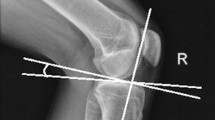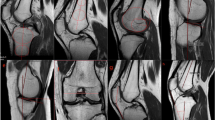Abstract
Purpose
The purpose of this meta-analysis was (1) to examine the effect of the tibial plateau slopes (medial and lateral) on anterior cruciate ligament (ACL) injury and (2) to investigate gender differences between ACL-injured subjects and gender-matched controls.
Methods
The PubMed database was searched through to 1 November 2011 to identify studies that met pre-stated inclusion criteria. Reference lists of retrieved articles were also reviewed. Two authors independently extracted information on the designs of the studies, the characteristics of the study participants, exposure and outcome assessments, and control for potential confounding factors. A meta-analysis was conducted, and either a fixed- or a random-effects model was used to calculate the overall weighted mean difference (WMD).
Results
Twelve studies (n = 1,871: 923 patients in the ACL-injured group and 938 patients in the control group) were included. The medial tibial plateau slope in the ACL group ranged from 1.8° ± 3.7° to 12.1° ± 3.3° while it ranged from 2.9° ± 2.8° to 9.5° ± 3° among the controls. The lateral tibial plateau slope in the ACL ranged from 1.8° ± 3.2° to 11.5° ± 3.5° and 0.3° ± 3.6° to 9° ± 4° in the control group. Statistically significant increased angles were observed in ACL-injured group compared to control group for medial tibial plateau slope (WMD, 1.1°; 95 % confidence interval, 0.5°–1.7°) and lateral tibial plateau slope (WMD, 1.8°; 95 % confidence interval, 1.3°–2.3°). Sensitivity analysis and subgroup analysis proved this to be a reliable result.
Conclusions
The current meta-analysis suggests that both, increased medial and lateral tibial plateau slopes, are associated with increased susceptibility to ACL injury regardless of gender. In addition, this study indicates a stronger evidence for lateral tibial plateau slope to be associated with ACL injury compared with medial tibial plateau slope due to the larger increased angle value and on the basis of consistency among the included studies.
Level of evidence
III.
















Similar content being viewed by others
References
Agel J, Arendt EA, Bershadsky B (2005) Anterior cruciate ligament injury in national collegiate athletic association basketball and soccer: a 13-year review. Am J Sports Med 33:524–530
Arendt EA (2001) Anterior cruciate ligament injuries. Curr Women’s Health Rep 1:211–217
Brazier J, Migeaud H, Gougeon F, Cotten A, Fontaine C, Duquennoy A (1996) Evaluation of methods for radiographic measurement of the tibial slope. A study of 83 healthy knees. Rev Chir Orthop Reparatrice Appar Mot 82:195–200
Begg CB, Mazumdar M (1994) Operating characteristics of a rank correlation test for publication bias. Biometrics 50:1088–1101
Bisson LJ, Gurske-DePerio J (2010) Axial and sagittal knee geometry as a risk factor for noncontact anterior cruciate ligament tear: a case-control study. Arthroscopy 26:901–906
Brandon ML, Haynes PT, Bonamo JR, Barrett GR, Sherman MF (2006) The association between posterior-inferior tibial slope and anterior cruciate ligament insufficiency. Arthroscopy 22:894–899
Butler DL, Noyes FR, Grood ES (1980) Ligamentous restraints to anterior-posterior drawer in the human knee. A biomechanical study. J Bone Joint Surg Am 62(2):259–270
Chan SC, Seedhom BB (1995) The effect of the geometry of the tibia on prediction of the cruciate ligament forces: a theoretical analysis. Proc Inst Mech Eng 209:17–30
Cimino F, Volk BS, Setter D (2010) Anterior cruciate ligament injury: diagnosis, management, and prevention. Am Fam Physician 82(8):917–922
Daniel DM, Stone ML, Dobson BE, Fithian DC, Rossman DJ, Kaufman KR (1994) Fate of the ACL-injured patient: a prospective outcome study. Am J Sports Med 22:632–644
Dejour H, Bonnin M (1994) Tibial translation after anterior cruciate ligament rupture. Two radiological tests compared. J Bone Joint Surg Br 76(5):745–749
Dejour D, Bonin N, Localetti E (2000) Tibial anterecurvatum osteotomies. Oper Tech Sports Med 8:67–70
DerSimonian R, Laird N (1986) Meta-analysis in clinical trials. Control Clin Trials 7:177–188
Egger M, Smith GD, Phillips AN (1997) Meta-analysis: principles and procedures. BMJ 315:1533–1537
Egger M, Davey Smith G, Schneider M, Minder C (1997) Bias in meta-analysis detected by a simple, graphical test. BMJ 315:629–634
Feucht MJ, Mauro CS, Brucker PU, Imhoff AB, Hinterwimmer S (2012) The role of the tibial slope in sustaining and treating anterior cruciate ligament injuries. Knee Surg Sports Traumatol Arthrosc. doi:10.1007/s00167-012-1941-6
Fridén T, Jonsson A, Erlandsson T, Jonsson K, Lindstrand A (1993) Effect of femoral condyle configuration on disability after an anterior cruciate ligament rupture. 100 patients followed for 5 years. Acta Orthop Scand 64:571–574
Giffin JR, Shannon FJ (2007) The role of the high tibial osteotomy in the unstable knee. Sports Med Arthrosc 15(1):23–31
Giffin JR, Stabile KJ, Zantop T, Vogrin TM, Woo SL, Harner CD (2007) Importance of tibial slope for stability of the posterior cruciate ligament deficient knee. Am J Sports Med 35(9):1443–1449
Giffin JR, Vogrin TM, Zantop T, Woo SL, Harner CD (2004) Effects of increasing tibial slope on the biomechanics of the knee. Am J Sports Med 32:376–382
Griffin LY, Albohm MJ, Arendt EA, Bahr R, Beynnon BD, Demaio M, Dick RW, Engebretsen L, Garrett WE Jr, Hewett TE, Huston LJ, Ireland ML, Johoson RJ, Lephart S, Mandelbaum BR, Mann BJ, Marks PH, Marshall SW, Myklebust G, Noyes FR, Powers C, Shields C Jr, Shultz SJ, Silvers H, Slauterbeck J, Taylor DC, Teitz CC, Wojtys EM, Yu B (2006) Understanding and preventing noncontact anterior cruciate ligament injuries: a review of the Hunt Valley II meeting. Am J Sports Med 34:1512–1523
Hashemi J, Chandrashekar N, Mansouri H, Gill B, Slauterbeck JR, Schutt RC Jr, Dabezies E, Beynnon BD (2010) Shallow medial tibial plateau and steep medial and lateral tibial slopes. Am J Sports Med 38:54–62
Hohmann E, Bryant A, Reaburn P, Tetsworth K (2010) Dose posterior tibial slope influence knee functionality in the anterior cruciate ligament-deficient and anterior cruciate ligament-reconstructed knee? Arthroscopy 26:1496–1502
Hohmann E, Bryant A, Reaburn P, Tetsworth K (2011) Is there a correlation between posterior tibial slope and non-contact anterior cruciate ligament injuries? Knee Surg Sports Traumatol Arthrosc Suppl 1:S109–S114
Higgins JP, Thompson SG, Deeks JJ, Altman DG (2003) Measuring inconsistency in meta-analyses. BMJ 327:557–560
Hudek R, Fuchs B, Regenfelder F, Koch PP (2011) Is noncontact ACL injury associated with the posterior and meniscal slope? Clin Orthop Relat Res 469:2377–2384
Khan MS, Seon JK, Song EK (2011) Risk factors for anterior cruciate ligament injury: assessment of tibial plateau anatomic variables on conventional MRI using a new combined method. Int Orthop 35:1251–1256
Kessler MA, Behrend H, Henz S, Stutz G, Rukavina A, Kuster MS (2008) Function, osteoarthritis and activity after ACL-rupture: 11 years follow-up results of conservative versus reconstructive treatment. Knee Surg Sports Traumatol Arthrosc 16:442–448
Kostogiannis I, Swärd P, Neuman P, Fridén T, Roos H (2011) The influence of posterior-inferior tibial slope in ACL injury. Knee Surg Sports Traumatol Arthrosc 19:592–597
Liu W, Maitland ME (2003) Influence of anthropometric and mechanical variations on functional instability in the ACL deficient knee. Ann Biomed Eng 31:1153–1161
Mclean SG, Oh YK, Palmer ML, Lucey SM, Lucarelli DG, Ashton-Miller JA, Wojtys EM (2011) The relationship between anterior tibial acceleration, tibial slope, and ACL strain during a simulated jump landing task. J Bone Joint Surg Am 93:1310–1317
O’Connor J, Shercliff TL, Biden E, Goodfellow JW (1989) The geometry of the knee in the sagittal plane. Proc Inst Mech Eng H 203:223–233
Shultz SJ, Schmitz RJ, Nguyen AD (2008) Research Retreat IV: ACL injuries: the gender bias: April 3–5, 2008 Greensboro, NC. J Athl Train 43:530–531
Şenışık Seçkin, Özgürbüz Cengizhan, Ergün Metin, Yüksel Oğuz, Taşkıran Emin, İşlegen Çetin, Ertat Ahmet (2011) Posterior tibial slope as a risk factor for anterior cruciate ligament rupture in soccer players. J Sports Sci Med 10:763–767
Simon RA, Everharta JS, Nagaraja HN, Chaudhari AM (2010) A case-control study of anterior cruciate ligament volume, tibial plateau slopes and intercondylar notch dimensions in ACL-injured knees. J Biomech 43:1702–1707
Sonnery-Cottet B, Archbold P, Cucurulo T, Fayard JM, Bortolletto J, Thaunat M, Prost T, Chambat P (2011) The influence of the tibial slope and the size of the intercondylar notch on rupture of the anterior cruciate ligament. J Bone Joint Surg Br 93:1475–1478
Stijak L, Herzog RF, Schai P (2008) Is there an influence of the tibial slope of the lateral condyle on the ACL lesion? Knee Surg Sports Traumatol Arthrosc 16:112–117
Stroup DF, Berlin JA, Morton SC, Olkin I, Williamson GD, Rennie D, Moher D, Becker BJ, Sipe TA, Thacker SB (2000) Meta-analysis of observational studies in epidemiology: a proposal for reporting. Meta-analysis of observational studies in epidemiology (MOOSE) group. JAMA 283:2008–2012
Terauchi M, Hatayama K, Yanagisawa S, Saito K, Takagishi K (2011) Sagittal alignment of the knee and its relationship to noncontact anterior cruciate ligament injuries. Am J Sports Med 39:1090–1094
Todd MS, Lalliss S, Garcia E, Deberardino TM, Cameron KL (2010) The relationship between posterior tibial slope and anterior cruciate ligament injuries. Am J Sports Med 38:63–67
Torzilli PA, Deng X, Warren RF (1994) The effect of joint-compressive load and quadriceps muscle force on knee motion in the intact and anterior cruciate ligament-sectioned knee. Am J Sports Med 22:105–112
Voos JE, Suero EM, Citak M, Petrigliano FP, Bosscher MR, Wickiewicz TL, Pearle AD (2011) Effect of tibial slope on the stability of the anterior cruciate ligament-deficient knee. Knee Surg Sports Traumatol Arthrosc 20:1626–1631
Vyas S, van Eck CF, Vyas N, Fu FH, Otsuka NY (2011) Increased medial tibial slope in teenage pediatric population with open physes and anterior cruciate ligament injuries. Knee Surg Sports Traumatol Arthrosc 19:372–377
Wells GA, Shea B, O’Connell D, Petersen J, Welch V, Losos M, Tugwell P (2010) The Newcastle-Ottawa Scale (NOS) for assessing the quality of nonrandomized studies in meta-analyses; http://www.ohri.ca/programs/clinical_epidemiology/oxford.asp
Wordeman SC, Quatman CE, Kaeding CC, Hewett TE (2012) In vivo evidence for tibial plateau slope as a risk factor for anterior cruciate ligament injury a systematic review and meta-analysis. Am J Sports Med 40:1673–1681
Acknowledgments
This work was supported by the Fundamental Research Funds for the Central Universities of Central South University, the National Natural Science Foundation of China (2012zzts126), the Fundamental Research Funds for the Central Universities of Central South University, the National Natural Science Foundation of China (No. 30300396), the Provincial Science Foundation of Hunan (No. 09JJ3048), the Provincial Development and Reform Commission Project of Hunan (2007-896), the Graduate degree thesis Innovation Foundation of Hunan Province (CX-2010B102), and National Clinical Key Department Construction Projects of China.
Conflict of interest
The authors declare that they have no conflict of interest.
Author information
Authors and Affiliations
Corresponding author
Additional information
Chao Zeng and Ling Cheng contributed equally to this article.
Rights and permissions
About this article
Cite this article
Zeng, C., Cheng, L., Wei, J. et al. The influence of the tibial plateau slopes on injury of the anterior cruciate ligament: a meta-analysis. Knee Surg Sports Traumatol Arthrosc 22, 53–65 (2014). https://doi.org/10.1007/s00167-012-2277-y
Received:
Accepted:
Published:
Issue Date:
DOI: https://doi.org/10.1007/s00167-012-2277-y




